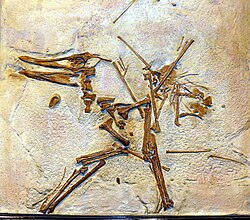History
In 1855, a fossil in a plate of shale from the Kimmeridgian, found near Nusplingen in Württemberg, holotype GPIT "Orig. Quenstedt 1855, Taf. 1" or GPIT 80, was named Pterodactylus suevicus by Friedrich August Quenstedt. [2] [3] [4] The specific name refers to the tribal area of Suevia. Quenstedt had earlier mentioned the find in a letter to Professor Heinrich Georg Bronn, which was published in 1854. In it he used the name Pterodactylus württembergicus. [5] In 1855 and 1858, Christian Erich Hermann von Meyer adopted this older species name [6] but it would be forgotten afterwards. The publication in 1854 was not meant to be a nomenclatural act. [7] According to Peter Wellnhofer, Pterodactylus württembergicus should be considered a nomen oblitum . [8]
In 1858, Johann Andreas Wagner described a second specimen consisting of the wings, a shinbone and a foot. He named it Pterodactylus (Ornithocephalus) eurychirus, "the broad-handed", but later in the same publication used the name Pterodactylus suevicus eurychirus as if it were a subspecies. [9] This is today considered a junior synonym. The specimen was acquired by the Bayerische Staatssammlung für Paläontologie und Geologie but was lost in April 1944 during the Munich bombardment. [8]
In 1870, Harry Govier Seeley assigned P. suevicus to a new genus: Cycnorhamphus. [10] The name is derived from Greek κύκνος, kyknos, "swan" and ράμφος, ramphos, "beak", in reference to the snout shape. The type species of this genus is Pterodactylus suevicus, the combinatio nova is Cycnorhamphus suevicus.
In 1878, Oscar Fraas referred a specimen of Pterodactylus longicollum , the later Exemplar Nr 58, to Pterodactylus suevicus. [11] Seeley made this the type specimen of yet another species: Cycnorhamphus Fraasii, in 1891. [12]
In 1907 however, Felix Plieninger rejected the split between Pterodactylus and Cycnorhamphus and denied the validity of C. fraasii. [13] This would be the standard interpretation, shared by most paleontologists, for over sixty years.
During the late 1960s, the Ghirardi family began to exploit the chalkstone quarries of Les Besson, located on the French army base of Canjuers near Aiguines. A Lagerstätte proved to be present from which many high quality fossils could be collected. One of these was a slab showing a pterosaur. The precise time and location of this discovery are unknown. It was first reported in the scientific literature in 1971, by Léonard Ginsburg and Guy Mennessier. [14] In 1974, French paleontologist Jacques Fabre based on this specimen, MNHN CNJ-71, named a new species Gallodactylus canjuersensis. [15] The generic name combines a reference to Gallia with Greek daktylos, "finger". He concluded it was the same genus as P. suevicus, but did not revive Cycnorhamphus, judging that the latter name was unavailable because of mistakes in the diagnosis by Seeley, already pointed uit by Plieninger. P. suevicus thus became Gallodactylus suevicus. In 1976, Fabre again named the species, describing it in greater detail but not mentioning the earlier publication. [16] This confused later researchers who mistakenly assumed that 1976 was the formal naming date. In fact the 1974 paper contains a sufficient description and the species was validly named that year. [7] In 1983, the Ghirardis sold their entire collection to the National Museum of Natural History, France.
However, in 1996, Christopher Bennett pointed out that such mistakes do not invalidate a name and that therefore Cycnorhamphus has priority, making Gallodactylus canjuersensisC. canjuersensis. [4] In 2010 and 2012, Bennett published further re-studies of the fossils, concluding that the differences between the two species could be explained by age, sex or individual variation, and formally synonymized C. canjuersensis and C. suevicus. [7]















